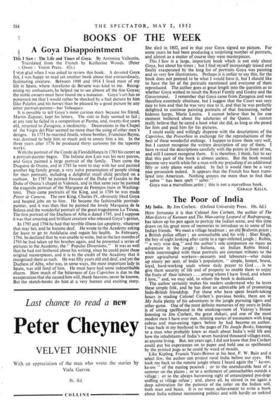F BOOKS OF THE WEEK
. A Goya Disappointment
I WAS glad when I was asked to review this book. A devoted Goya far!, I was happy to read yet another book about that extraordinary, fastinating creature. Between 1908 and 1914 I lived most of my life in Spain, where Aureliano de Beruete was kind to me. Recog- nising my enthusiasm, he helped me to see almost all the fine Goyas; the noble owners must have found me a nuisance. Goya's art has so possessed me that I would rather be shocked by a bad picture by him (like Palafox and his horse) than be pleased by a good picture by any other portrait-painter—bar Velasquez.
It is possible to tell Goya's most curious story because his friend, Martin Zapater, kept his letters. The visit to Italy seemed to fail ; at any rate he failed in a competition at Parma, and, twenty-five years old, returned to Zaragoza, a mediocrity. Decorations in the Chapel of the Virgin del Pilar seemed no more than the using of other men's designs. In 1775 he married Josefa, whose brother, Francisco Bayeu, was destined to help him so much and to annoy him a lot. In the three years after 1776 he produced thirty cartoons for the tapestry works.
With the portrait of the Conde de Floridablanca in 1783 his career as a portrait-painter began. The Infante don Luis was his next patron, and Goya painted a large portrait of the family. Then came the Duquesa de Osuna, and in 1785 he went to stay with her and painted another big family group, a very naive presentation of people sitting for their portraits, including a delightful small child perched on a cushion. In 1787 he painted frescoes of the Duke of Gandia in the Duke of Osuna's chapel in Valencia, and in that same year he painted the exquisite portrait of the Marquese de Pontejos (now in Washing- ton). Then came portraits of the King, and in 1789 he was made Pintor de Camera. The new King, Charles IV, obviously liked Goya and heaped jobs on to him. He became the fashionable portrait- painter, and it was then that he painted the lovely Marquesa de la Solana and the wonderful portrait of the great. tragedienne La Tirana. The first portrait of the Duchess of Alba is dated 1795, and I suppose it was that amazing and brilliant creature who released Goya's genius, In 1793 and 1794 he had that terrible illness (an apoplexy, whatever that may be), and he became deaf. He wrote to the Academy asking for leave to go to Andalucia and regain his health. In February, 1794, he declared that he was unable to write, but in the last months of 1793 he had taken up his brushes again, and he presented a series of pictures to the Academy, the." Popular Diversions." It was as well that he had not bothered about his writing, since he could paint these original masterpieces, and it is to the credit of the Academy that it recognised them as such. He was fifty years old and deaf, and yet the Duchess of Alba, who was, in some ways, the most important lady in Spain, was still fond of him. He must have had some indescribable charm. How much of the bitterness of Los Caprichos is due to the exasperation that she caused him will, thank heavens, never be known. But the sketch-books do hint at a very human and exciting story. She died in 1802, and in that year Goya signed no picture. For some years he had been producing a surprising number of portraits, and almost as a matter of course they were masterpieces.
This I Saw is a large, important book which is not only about Goya, but about his times ; but I find myself increasingly teased and finally exasperated by the long list of portraits Goya was painting and so very few illustrations. Perhaps it is unfair to say this, for the book does not pretend to be what I would have it, but I should like to have the list of the portraits mentioned and everyone of them reproduced. The author goes at great length into the question as to whether Goya wished to insult the Royal Family and Godoy and the Government. I remember that Goya came from Zaragoza and was therefore extremely obstinate, but I suggest that the Court was very nice to him and that he was very nice to it, and that he was perfectly delighted to continue painting portraits of that fascinating, rather hideous harpy, Maria Louisa. I cannot believe that he for one moment bothered about the adulteries of the Queen. I cannot really believe that he cared a hoot what she did, as long as she posed for him and paid him for his pictures.
I could easily and willingly dispense with the descriptions of the Caprichos, the Proverbios in exchange for the reproductions of the best of these wonderful etchings. I happen to know them very well, but I cannot recognise the written description of any of them. I have re-read the descriptions carefully with the prints in front of me, and still I cannot recognise them. It is therefore, I think, fair to say that this part of the book is almost useless. But the book would become very worth while for a man with my prejudices if an additional fifty or sixty plates were added. In fact it would then be a very nice possession indeed. It appears that the French has been trans- lated into American. Nothing annoys me more than to find that " sabre " has been spelt " saber."
Goya was a marvellous,artist ; this is not a marvellous book.
GERALD KELLY.


































 Previous page
Previous page